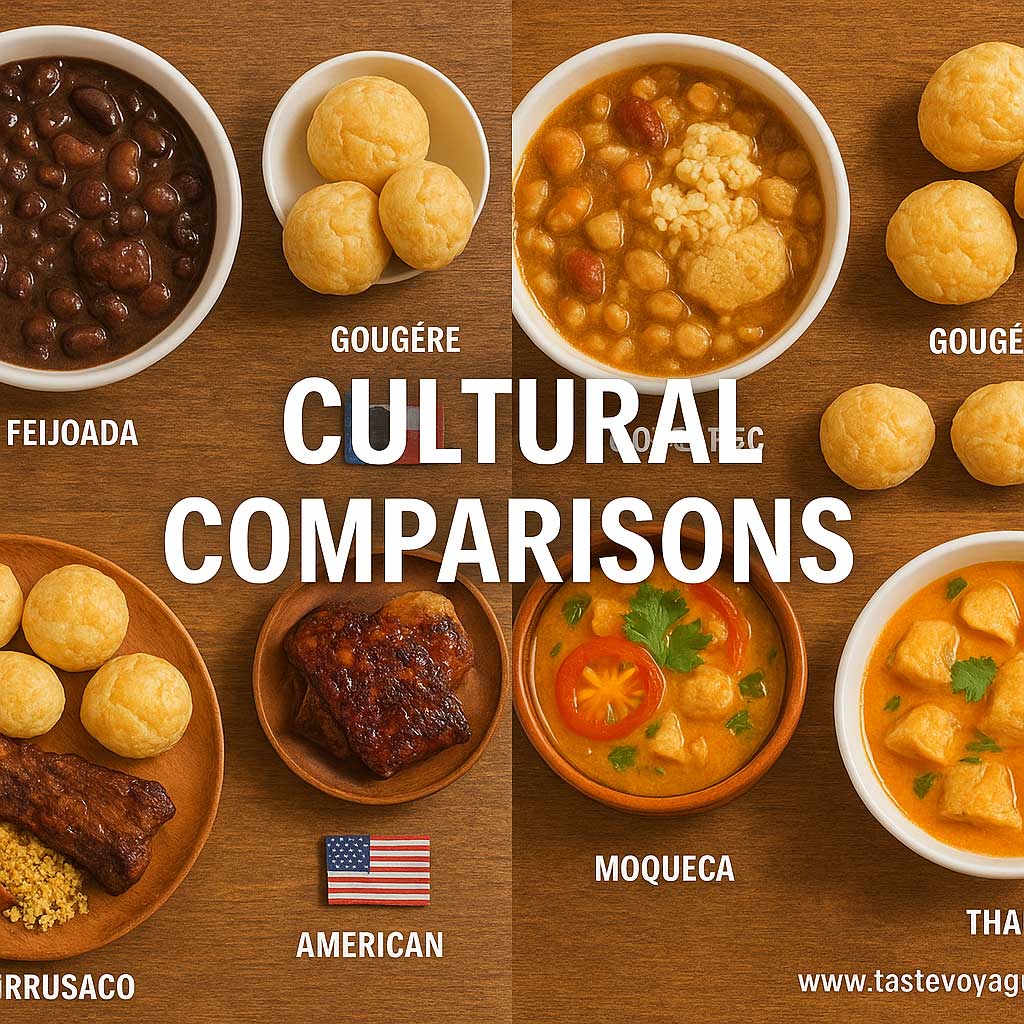Brazilian vs American BBQ: Which is Better?
Travel the World Through Food >> Brazilian Cuisine>>Cultural Comparisons>> Brazilian vs American BBQ: Which is Better?
Brazilian vs American BBQ: Which is Better?
Brazilian vs. American BBQ Comparison
Barbecue is a beloved culinary tradition that brings people together with its rich flavors and communal spirit. Among the many styles of barbecue around the world, Brazilian and American barbecue stand out for their unique techniques, flavors, and cultural significance. Exploring these two styles offers a fascinating window into diverse culinary heritages and the social customs that surround them. Let’s delve into the cultural value and culinary importance of Brazilian and American barbecue, highlighting what makes each style special.
The Heart of Brazilian Barbecue
Brazilian barbecue, often called churrasco, is a celebration of community and flavor. Originating from the southern regions of Brazil, churrasco is deeply rooted in social gatherings and family traditions. It is characterized by its emphasis on high-quality cuts of meat, which are seasoned simply and grilled to perfection over open flames. The experience often revolves around a continuous serve of skewered meats, allowing guests to sample a variety of flavors.
Culturally, Brazilian barbecue symbolizes hospitality and togetherness. The practice of churrasco is often accompanied by lively music, laughter, and shared stories, making it more than just a meal—it’s a social event. The use of traditional techniques, such as slow cooking over wood or charcoal, enhances the natural flavors of the meat, creating a culinary experience that is both hearty and refined.
The Rich Tradition of American BBQ
American barbecue is a diverse and vibrant tradition that varies significantly across regions. From the smoky ribs of the American South to the brisket of Texas, each style reflects local ingredients, climate, and history. It is deeply intertwined with regional identities and communal gatherings, such as cookouts, festivals, and family reunions.
American BBQ is distinguished by its methods of slow smoking, marinades, and rubs, which impart complex layers of flavor. The art of barbecue in the United States often involves specific techniques like pit-smoking or using specialized smokers. These methods preserve the meat’s tenderness and infuse it with smoky goodness. American barbecue also emphasizes sauces—ranging from tangy tomato-based to sweet molasses and spicy mustard varieties—that complement the meat and add an extra dimension of taste.
Cultural Significance and Social Traditions
Both Brazilian and American barbecues serve as more than just culinary practices; they are expressions of cultural identity and social cohesion. In Brazil, churrasco often gathers friends and family for hours of shared eating and celebration, fostering a sense of community and tradition. It reflects a lifestyle that values connection, generosity, and the enjoyment of good food.
In the United States, barbecue functions as a communal activity that brings people together regardless of background. Whether at a lively festival or a quiet family backyard, American barbecue signifies friendship, celebration, and the celebration of regional heritage through food. It often acts as a symbol of local pride, with each region boasting its own signature flavors and techniques.
Culinary Significance and Techniques
Culinary-wise, both styles highlight the importance of quality ingredients and mastery of slow, careful cooking. Brazilian churrasco emphasizes simple, flavorful seasoning—often just salt—to let the meat’s natural taste shine through. The focus is on grilling large cuts of beef, pork, or chicken over open flames, frequently seasoned with coarse salt and sometimes accompanied by traditional sides like farofa (toasted cassava flour) and pão de queijo (cheese bread).
American barbecue is characterized by its complex flavor profiles achieved through marinades, dry rubs, and Sauces. The slow smoking process can take hours or even days, depending on the cut and style. Each region’s techniques evolve from local ingredients and preferences, resulting in a rich tapestry of flavors and textures.
Celebrating the Culinary Diversity
Both Brazilian and American barbecue exemplify how food can serve as a reflection of cultural values and social bonds. They showcase the importance of tradition, craftsmanship, and community in culinary practices. Whether it’s the vibrant, social churrasco or the slow-cooked, flavor-packed American barbecue, these styles celebrate the art of grilling and the joy of sharing a meal with loved ones.
In conclusion, exploring the comparison between Brazilian and American barbecue reveals not just differences in techniques and flavors but also the profound cultural stories embedded within each tradition. Both styles continue to evolve, inviting new generations to partake in their timeless appeal. No matter the region, barbecue remains a universal language of connection, flavor, and celebration.
